Search Thermo Fisher Scientific
Invitrogen
14-3-3 Pan Polyclonal Antibody
This Antibody was verified by Knockdown to ensure that the antibody binds to the antigen stated.
FIGURE: 1 / 16
14-3-3 Pan Antibody (51-0700) in ICC/IF
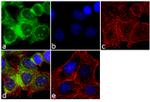
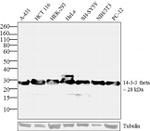
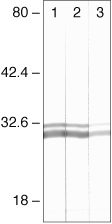

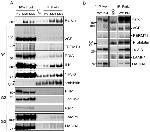
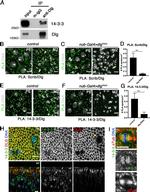

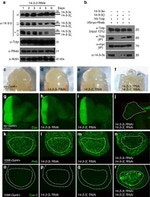
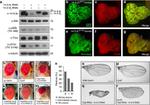
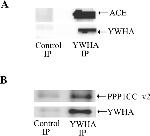

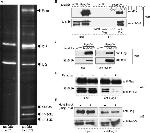
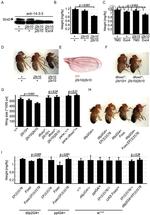
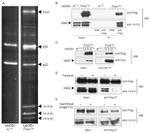
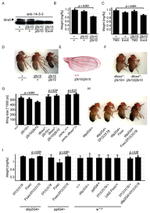

Product Details
51-0700
Species Reactivity
Published species
Host/Isotype
Class
Type
Immunogen
Conjugate
Form
Concentration
Purification
Storage buffer
Contains
Storage conditions
Shipping conditions
RRID
Product Specific Information
This antibody is broadly reactive with members of the 14-3-3 family of proteins (~29-32 kDa). With the exception of a single conserved amino acid change, this sequence is identical in the delta and zeta isoforms. Three and four conserved amino acid differences are found in the tau and gamma isoforms, respectively.
Based on the sequence homology to the immunizing peptide, this the antibody could recognize the protein from C. elegans.
Target Information
At least seven isoforms comprise the highly conserved 14-3-3 family of homo- and heterodimeric proteins that are abundantly expressed in all eukaryotic cells. Although more than seven isoforms of 14-3-3 have been described, some redundancies have appeared upon sequencing. The 14-3-3s are thought to be key regulators of signal transduction events mediated through their binding to serine-phosphorylated proteins. By interacting with Cdc25C, 14-3-3 regulates entry into the cell cycle and, through interaction with Bad, prevents apoptosis. Other proteins that have been shown to bind to 14-3-3s include members of the protein kinase C family, Cbl, IRS-1, polyoma middle-T antigen, nitrate reductase, S-raf and the IGF-1 receptor. Detection of 14-3-3 proteins in cerebrospinal fluid has been shown to be quite useful in the differential diagnosis of Creutzfeldt-Jakob disease and other prion diseases.
For Research Use Only. Not for use in diagnostic procedures. Not for resale without express authorization.
Bioinformatics
Protein Aliases: 14-3-3 alpha; 14-3-3 beta; 14-3-3 delta; 14-3-3 epsilon; 14-3-3 gamma; 14-3-3 protein beta; 14-3-3 protein beta-subtype; 14-3-3 protein beta/alpha; 14-3-3 protein beta/alpha-A; 14-3-3 protein beta/alpha-B; 14-3-3 protein epsilon; 14-3-3 protein gamma; 14-3-3 protein gamma subtype; 14-3-3 protein gamma-A; 14-3-3 protein gamma-B; 14-3-3 protein gamma-subtype; 14-3-3 protein sigma; 14-3-3 protein T-cell; 14-3-3 protein tau; 14-3-3 protein theta; 14-3-3 protein zeta/delta; 14-3-3 protein/cytosolic phospholipase A2; 14-3-3 sigma; 14-3-3 sigma protein; 14-3-3 tau; 14-3-3 theta; 14-3-3 zeta; 14-3-3d; 14-3-3E; 3-monooxgenase/tryptophan 5-monooxgenase activation protein, gamma polypeptide; 3-monooxgenase/tryptophan 5-monooxygenase activation protein, gamma polypeptide; 3-monooxygenase/tryptophan 5 monooxygenase activation protein beta polypeptide; 3-monooxygenase/tryptophan 5-monooxgenase activation protein gamma polypeptide; 3-monooxygenase/tryptophan 5-monooxygenase activation protein, gamma polypeptide; brain protein 14-3-3, beta isoform; epididymis luminal protein 2; epididymis luminal protein 4; epididymis secretory protein Li 1; epididymis secretory protein Li 3; epididymis secretory protein Li 93; Epithelial cell marker protein 1; Factor activating exoenzyme S; FAS; KCIP-1; mitochondrial import stimulation factor (MSF) L subunit; Mitochondrial import stimulation factor L subunit; Mitochondrial import stimulation factor S1 subunit; MSF L; phospholipase A2; Prepronerve growth factor RNH-1; Protein 1054; Protein HS1; Protein kinase C inhibitor protein 1; protein kinase C inhibitor protein-1; protein phosphatase 1, regulatory subunit 170; protein tau; protein, theta; SEZ-2; Stratifin; tryosine 3-monooxgenase/tryptophan 5 monooxgenase activation protein gamma; tryosine 3-monooxgenase/tryptophan 5-monooxgenase activation protein gamma polypeptide; tryosine 3-monooxygenase/tryptophan 5-monooxygenase activation protein beta polypeptide; tryosine 3-monooxygenase/tryptophan 5-monooxygenase activation protein gamma; tyrosine 3-monooxgenase/tryptophan 5 monooxgenase activation protein beta polypeptide; tyrosine 3-monooxgenase/tryptophan 5 monooxgenase activation protein, beta polypeptide; tyrosine 3-monooxgenase/tryptophan 5-monooxgenase activation protein, beta polypeptide; tyrosine 3-monooxgenase/tryptophan 5-monooxgenase activation protein, gamma polypeptide; tyrosine 3-monooxygenase/tryptophan 5-monooxygenase activation protein, alpha polypeptide; tyrosine 3-monooxygenase/tryptophan 5-monooxygenase activation protein, beta polypeptide; tyrosine 3-monooxygenase/tryptophan 5-monooxygenase activation protein, delta polypeptide; tyrosine 3-monooxygenase/tryptophan 5-monooxygenase activation protein, epsilon polypeptide; tyrosine 3-monooxygenase/tryptophan 5-monooxygenase activation protein, gamma polypeptide; tyrosine 3-monooxygenase/tryptophan 5-monooxygenase activation protein, sigma polypeptide; tyrosine 3-monooxygenase/tryptophan 5-monooxygenase activation protein, theta polypeptide; tyrosine 3-monooxygenase/tryptophan 5-monooxygenase activation protein, zeta polypeptide; tyrosine 3-monooxygenase/tryptophan 5-monooxygenase activatioprotein epsilon polypeptide; tyrosine 3-monooxygenase/tryptophan 5-monooxygenase activatioprotein, epsilon polypeptide; tyrosine 3/tryptophan 5 -monooxygenase activation protein beta polypeptide; tyrosine 3/tryptophan 5 -monooxygenase activation protein gamma polypeptide; tyrosine 3/tryptophan 5 -monooxygenase activation protein, beta polypeptide; tyrosine 3/tryptophan 5 -monooxygenase activation protein, epsilon polypeptide; tyrosine 3/tryptophan 5 -monooxygenase activation protein, gamma polypeptide; tyrosine 3/tryptophan 5 -monooxygenase activation protein, theta polypeptide; tyrosine 3/tryptophan 5 -monooxygenase activation protein, zeta polypeptide
Gene Aliases: 1110013I11Rik; 1300003C17Rik; 14-3-3; 14-3-3-zeta; 14-3-3beta; 14-3-3E; 14-3-3G; 14-3-3GAMMA; 14-3-3t; 14-3-3z; 14-3-3zeta; 1C5; 2700028P07Rik; AA409740; AI596267; AL022924; AU019196; AU020854; AU021156; D7Bwg1348e; Er; GW128; HEL-S-1; HEL-S-3; HEL-S-93; HEL2; HEL4; HME1; HS1; KCIP-1; MDCR; MDS; Mkrn3; Mme1; Msfs1; PPP1R170; R74690; SFN; XELAEV_18012695mg; XELAEV_18015318mg; XELAEV_18043238mg; XELAEV_18045999mg; YWHAA; YWHAB; ywhab-a; ywhab-b; YWHAD; YWHAE; YWHAG; ywhag-a; ywhag-b; YWHAQ; YWHAS; YWHAZ
UniProt ID: (Bovine) Q0VC36, (Human) P31947, (Mouse) O70456, (Bovine) P68250, (Human) P31946, (Bovine) P62261, (Human) P62258, (Human) P61981, (Human) P27348, (Bovine) Q3SZI4, (Human) P63104, (Bovine) P63103, (Mouse) Q9CQV8, (Rat) P35213, (Mouse) P62259, (Rat) P62260, (Mouse) P61982, (Rat) P61983, (Rat) P68255, (Mouse) P68254, (Mouse) P63101, (Rat) P63102, (Xenopus) Q5XHK2, (Xenopus) Q8AVQ3, (Xenopus) Q6PCG0, (Xenopus) Q6NRY9
Entrez Gene ID: (Bovine) 528453, (Human) 2810, (Mouse) 55948, (Rat) 313017, (Bovine) 286863, (Human) 7529, (Bovine) 282125, (Human) 7531, (Human) 7532, (Bovine) 286862, (Human) 10971, (Bovine) 768311, (Human) 7534, (Bovine) 287022, (Mouse) 54401, (Rat) 56011, (Mouse) 22627, (Rat) 29753, (Mouse) 22628, (Rat) 56010, (Rat) 25577, (Mouse) 22630, (Mouse) 22631, (Rat) 25578, (Xenopus) 399276, (Xenopus) 380457, (Xenopus) 379724, (Xenopus) 432005, (Xenopus) 100505434

Performance Guarantee
If an Invitrogen™ antibody doesn't perform as described on our website or datasheet,we'll replace the product at no cost to you, or provide you with a credit for a future purchase.*
Learn more
We're here to help
Get expert recommendations for common problems or connect directly with an on staff expert for technical assistance related to applications, equipment and general product use.
Contact tech support
